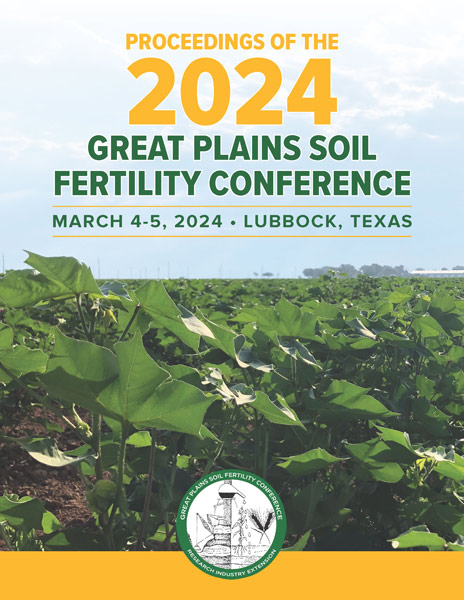Conference Proceedings Available!
Proceedings
Authors
| Filter results8 paper(s) found. |
|---|
1. Enhanced Efficiency Nitrogen Fertilizer: Coated UreaNitrogen (N) is the most common fertilizer. However, a large percentage is lost to the environment—resulting in pollution and depletion of natural resources—representing economic losses. Enhanced Efficiency Fertilizers (EEF) help mitigate these problems by reducing the time N is in forms most susceptible to loss, increasing uptake efficiency and, often, yield and/or crop quality. One example of N EEF are coated urea fertilizers, such as polymer coated urea (PCU). Research studies show... S. Fahning, B.G. Hopkins |
2. Enhanced Efficiency Phosphorus FertilizersPhosphorus (P) is essential for plants. However, first-year phosphorus fertilizer uptake by plants is low, resulting in economic and environmental impacts. Developments with P Enhanced Efficiency Fertilizer (EEF) sources show improved uptake efficiency and increased yield and/or crop quality, while reducing environmental risk. Research with EEFs (including organic acids, maleic itaconic copolymer, and struvite) all show these improvements, especially when: 1) soil test P concentrations are low,... S. Kobza, B.G. Hopkins |
3. Soil Analysis Methods Accuracy and Precision Comparison: Historical North American Proficiency Testing (NAPT) Program ResultsThe SSSA-NAPT Program provides open access to soil, water, and plant laboratory data. This data is collected quarterly from about 150 participating laboratories. For soil data, five samples are sent to participant laboratories for them to submit data for any or all of the 99 accepted methods. Our objective was to evaluate data precision from 43 soil samples (2019-2021). A measure of precision was made by dividing the Median Absolute Deviation (MAD) by the Median for each of the 43 samples... B.G. Hopkins, G.E. Cardon, J.R. Lawley |
4. Microplastics in Sweet Corn: Polymer Coated FertilizersPolymer coated fertilizers enhance nutrient efficiency and potentially reduce environmental nutrient loss. However, heavy runoff can carry microplastics into waterways and could negatively impact aquatic or terrestrial environments (Alimi, 2018). The objective of this project is to determine the microplastics concentrations in runoff water in sweet corn (Zea mays ‘sweetness’) with various placement methods. The full factorial study design consisted of three fertilizer... B.G. Hopkins, B.T. Geary, C.J. Seely |
5. Microplastics in Urban Landscapes: Polymer Coated FertilizersThe introduction and use of polymer coated fertilizers in urban landscapes has proven beneficial in supplying nutrients with less loss to the environment. However, these have recently come under scrutiny due to concerns with microplastics in the environment (Alimi). The objectives of this study were to determine the microplastics concentrations in runoff water in urban landscapes. The full factorial study design consisted of three fertilizer sources (Uncoated Dry and Coated Dry) with all... C.J. Seely, B.T. Geary, B.G. Hopkins |
6. Nutrient Distribution and Uptake: Homogeneous Vs. Heterogeneous Fertilizer BlendsApplication of concentrated boron (B) fertilizers is potentially a problem for crops with a narrow root cylinder as some plants may receive the B while others are not in close enough proximity. The objective of this trial was to evaluate a low concentration B fertilizer in a variety of crops. Uptake of B was measured and compared to known B sufficiency levels. Crops with a relatively narrow root cylinder diameter (Kentucky bluegrass turfgrass, onion, carrot, and alfalfa) that were fertilized with... J.D. Ioannou, B.G. Hopkins |
7. Stacking Nutrient 4Rs on Potato and WheatThe 4 Rs of nutrient management are a set of research-based guidelines for farmers to use when applying fertilizers to their crops. The aim of the 4 Rs is to improve the sustainability of major cropping systems and the environment without compromising crop yield and quality. The objective for this project is to evaluate individual and stacked 4 R management practices and how they intersect. We conducted this experiment on a Russet Burbank potato crop grown at a field near Grace, Idaho in 2020.... S.H. Stapley, N.C. Hansen, M.A. Yost, E.A. Woolley, B.G. Hopkins |
8. A New Hydroponic System for Testing Mineral Nutrient Deficiencies and It's Application to SoybeansCorrelating plant tissue nutrient concentrations with visual symptoms is valuable in combating mineral nutrient deficiencies and toxicities. Due to changing climates and decreasing water supplies throughout the world, agricultural lands need to improve nutrient and water management in crops, including soybeans (Glycine max L.).Because nutrient concentrations can be easily controlled, hydroponics effectively demonstrate isolated specific nutrient related symptoms. However, many hydroponic... A.M. Lambert, S.M. Anderson, D.L. Cole, A. Haderlie, C.J. Seely, B.G. Hopkins |
